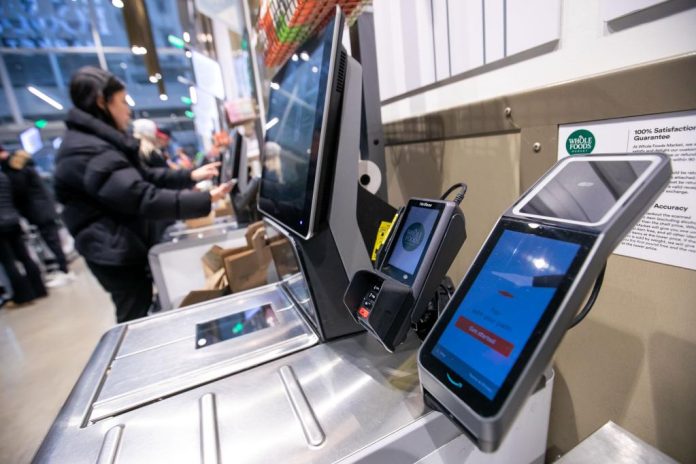Your wallet is all in the palm of your hand.
Whole Foods shoppers in NYC have recently noticed a curious new way of paying for their groceries, which requires simply waving a hand over a reader instead of swiping a card or tapping a phone.
Called Amazon One, the company says customers “will no longer need their wallet or even a phone to pay” thanks to the touch-free reader.
“I’ve never seen it before,” Christian Keenan, 28, said during his visit to the Wall Street store on Friday. “This is the first time I’ve come across it.”
“I’m confused,” Troy Bechet, 60, said at the Bryant Park location. “It doesn’t freak me out. I’d have to do a little more research on it.”
MJ Jervinsky, 47, paid with her hand at the same store on Friday and says she’s been using it since the fall.
“I love it, I have no problem with collecting all my information,” she said. “I don’t care. It’s just a lot easier.”
“I like that they have all my info so if I want to buy alcohol, I don’t have to show my ID,” she added.
The technology works by analyzing both a person’s unique skin pattern and “underlying vein structure,” according to the company, and links this “palm signature” to their Prime account and payment. It’s been in the works since 2020, but Amazon announced last summer it would roll out by the end of the year.
Now, it’s currently in every Whole Foods in the U.S. along with a Hudson Non-stop store in Newark Airport’s Terminal A, three Crunch Fitness locations in NYC as well as other locations and stadiums nationwide.
While Whole Foods chief technology officer Leandro Balbinot said in a statement that “customers love the convenience it provides,” not all shoppers are on board.
“I’ll be honest, it’s a little invasive for me,” Keenan said. “I can’t say that is something I’d be interested in.”

“It’s pretty cool. It’s faster,” Paresh Nag, 35, said, noting he would “definitely” use it someday. “But I’m not sure how safe it is right now.”
Estella Puertas, 56, didn’t notice Amazon One when she was shopping near Bryant Park on Friday, but she worries the scan might not be “good enough to see my hand.”
Amazon notes on its website that the biometric data — characteristics like a fingerprint used for automatic recognition — is not being used for tracking or market research, nor would be given to the government unless legally obliged to do so.
But Lisa Palmer, chief AI strategist for the consulting firm AI Leaders, warns that the fine print could change at any time, for any reason at the company’s discretion.

“You start out with the intention of using it to make payments, but we have no idea what this will ultimately be reused for,” she told The Post. “Once you’ve literally handed over your palm print, you no longer have control over your own biometric identity.”
Reps for both Whole Foods and its parent company Amazon declined to comment to The Post.
Palmer said the palm print-like readings could become as ubiquitous as a social security number someday, but said she also worries about how safely the data is stored.
Amazon ensured that images of people’s palms and veins are “encrypted and sent to a highly secure zone” and only select employees have access.

However, Palmer pointed out the many data breaches that have happened in recent years, citing the crippling cyber attack that debilitated Las Vegas casinos last summer and another recent one that severely disrupted business for Clorox.
“It has shifted from a matter to not if your data will be breached, but when,” she said.
Palmer said biometric data can be compromised in cyber thefts, something nearly half of the American population has experienced at one point in their lives.

“What is a company like Amazon going to do to mitigate the damage once your palm print has been stolen? You can’t unring that bell.”
Jervinsky, though, isn’t too worried about her data being stolen.
“I just figured Amazon’s a big enough company that they have to do the right thing or risk lawsuits,” she said. “I don’t think it has necessarily more risk than any other security breach, whether that’s somebody stealing your wallet or your card or bank account information.”

Amazon One could be trying to one-up other virtual transaction methods like Apple Pay, which about 75% of iPhone users enabled in 2022, according to the Wall Street Journal.
“Our data show that 95% of the time after people sign up for [Amazon One] and use it,” Amazon Vice President Dilip Kumar told WSJ in August. “They don’t go back to their prior way of identifying themselves.”
But some New Yorkers aren’t, well, buying it.

“I use my phone, I use my card. I don’t need another thing,” 26-year-old Nick Giannachi said during a trip to Whole Foods Bryant Park.
“I’m not sure that I’m comfortable giving my biometric information out like that,” Gregory, 44, added. “Maybe it’s one of those things you get used to, but I’m not there yet.”
While shopping at the Wall Street store, Teji Clark, 47, of Brooklyn, said “It’s too much information to give out.”
“It’s not for me,” he said. “I guess we got to get ready for the future.”
Source: NYPOST

